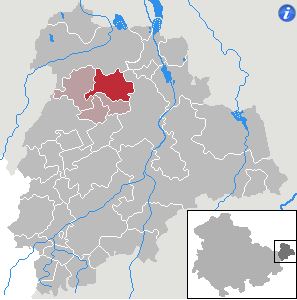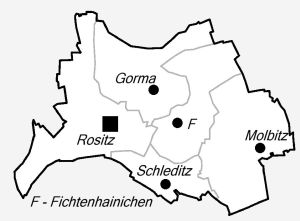Julius’s Ancestral Home
7
Rositz is a Verwaltungsgemeinschaft (“collective municipality”) in the district Altenburger Land, in Thuringia, Germany. The seat of the Verwaltungsgemeinschaft is in Rositz. Adjacent communities are (clockwise) Meuselwitz , the city Altenburg , Lödla , Monstab and Kriebitzsch .
Rositz is located five kilometers northwest of Altenburg in Thuringia in the Leipzig lowland bay .

History
Rositz was first mentioned in documents in 1181. The village was created as a Rundling . The place name, around 1200 Rosiz , at 1215 Rodesicz , may be of Sorbian origin.
In the 13th and 14th centuries, the burgraves of Altenburg had property in the village. [2] Later Rositz belonged to wettinischen Official Altenburg , [3] [4] which under the authority following the 16th century due to several divisions in the course of its existence Ernestine duchies was: Duchy axes (1554-1572), Herzogtum Saxony-Weimar(1572 to 1603), Duchy of Saxe-Altenburg (1603 to 1672), Duchy of Saxe-Gotha-Altenburg (1672 to 1826). When reorganizing the Ernestine duchies in 1826, the place came again to the Duchy of Saxe-Altenburg. After the administrative reform in the Duchy Rositz part relating to the management of Ostkreis (up to 1900) [5] or to the district office Altenburg (1900).
Lignite Mining
Through lignite mining, whose occurrence is first mentioned in 1672 in Fichtenhainichen, and the associated industrial settlements Rositz developed in the course of the 19th century from a rural village to an industrial large housing estate. Rositz is next to Meuselwitz a namesake of the Meuselwitz-Rositzer lignite mining area . 1872 opened the first Thuringian briquette factory and the sugar factory Rositz , which possessed the first electrical operating lighting of Germany. Other processing plants in Rositz were a smoldering (1918-1990) and the Teerverarbeitungswerk. The latter belonged to the German Petroleum Company ( DEA), with which in 1917 the first carbochemical operation of the big industry settled in the area at the location Rositz. [7] In Rositz existed several underground mines and several smaller open pits .
World War II
During the Second World War, eight camps for forced laborers were established in and around Rositz (Rositz I-VI, Untermolbitz and Schelditz ), in which more than a thousand forced laborers had to work: for the German Petroleum Company (DEA) , for the Rositzer sugar refinery , at K. Eisenrieth , Rositzer Kohlenwerke and Curt Plützsch . [10] Rositz is probably the place in Altenburger Land that was in World War II most destroyed. On August 16, 1944, the German Petroleum Actiengesellschaft (DEA) was hit so hard that for days a cloud of smoke was seen in several kilometers altitude; About 70 percent of the works was destroyed. Another bomb attack on the plant took place on 14 February 1945. Altogether 49 people died in both attacks.
Patton
Rositz – Village
Rositz is a village in the municipality of Rositz in the Thuringian district Altenburger Land . It is the seat of the administrative community Rositz. Also, in the Rositz community are the villages Gorma, Fichtenhainichen, Schleditz, and Molbitz.

Großröda
Großröda is a district of the eastern Thuringian community Starkenberg in the district Altenburger Land . Until 31 December 2011, the place was independent and was in the administrative community Altenburger Land .
History
Großröda was first mentioned on 1 August 976 as Rodiuue , when Emperor Otto II gave the place to the diocese Zeitz . In the year 1121, Rodowe was called the Monastery Bosau, which after the Reformation was the manor. The monastery Bosau was dissolved in 1573. On July 25, 1632 a conflagration raged in place.
Großröda was since the 17th century with the wettinischen Office Altenburg under the sovereignty of the following Ernestine duchies : Duchy of Saxe-Weimar (1572-1603), Duchy of Saxe-Altenburg (1603-1672), Duchy of Saxe-Gotha- Altenburg (1672-1826). First, the place was called only Röda. When the owners of the manor in 1703 built a village northwest of the manor, it was divided into Groß- and Kleinroda, In the reorganization of the Ernestine duchies in 1826, Großroda came again to the Duchy of Saxe-Altenburg.
In mid-April 1945, the place was occupied by US troops , from the beginning of July by the Red Army . Thus it became, like all of Thuringia, part of the Soviet occupation zone and from 1949 the GDR .
In the second district reform in the GDR in 1952, the existing countries were dissolved and the counties recut. Thus, Großröda came with the district of Altenburg to the district of Leipzig . In 1990, the town was re-affiliated with the district Altenburg of the Free State of Thuringia. Since 1994 Großröda belongs to the district Altenburger Land.
Lignite mining
The raw lignite mining played a role in the district from 1898 to 1927. Between 1945 and 1959, the mining was again carried out because there was an energy shortage. Großröda belongs to the Meuselwitz-Altenburger lignite mining area . The underground mine Eugenshacht north and west of Großröda was in operation between 1900 and 1960. Also in 1900 opened the briquette factory Eugen-Schacht , which produced until 1928. Northwest of Großröda lignite was mined in the open pit . This was first the open pit Eugen (1911 to 1915), then the open pit Gertrud II (1914 to 1932) and finally the open pit Gertrud III (Zechau) (1931 to 1959), the Großrödas neighboring Petsafell fell victim and only the scars on the loess remained after the end of brown coal mining . During World War II there was Anhaltisches Kohlenwerke, a camp with 280 forced laborers .
Monstab
Monstab is a municipality in the administrative community of Rositz in the Thuringian district Altenburger Land . It is located about 6 km west of the district town of Altenburg and on the southern edge of the Meuselwitz-Rositzer lignite mining district . Adjacent municipalities are (clockwise) Rositz , Lödla , Göhren , Starkenberg and Kriebitzsch .
History
Monstab was a Sorbian Rundling , which was called 976 Masceltorp , 1270 Mazeltoph and 1413 Monstaph . The place was first mentioned in a document in 976, when Emperor Otto II entrusted the place of the episcopal church to Zeitz . [2] It belonged later wettinischen Office Altenburg , [3] [4] which in the 16th century due to several divisions in the course of its existence under the sovereignty following Ernestine duchieswas: Duchy of Saxony (1554-1572), Duchy of Saxony Weimar(1572 to 1603), Duchy of Saxe-Altenburg (1603 to 1672), Duchy of Saxe-Gotha-Altenburg (1672 to 1826). In the reorganization of the Ernestine duchies in 1826 Monstab again came to the Duchy of Saxe- Altenburg. After the administrative reform in the Duchy of place belonged relating to the management of Ostkreis (to 1900) [5] or the district office Altenburg (1900). [6]The village belonged from 1918 to Saxony-Altenburg , 1920 in the state of Thuringia came up. 1922 it came to the district Altenburg .
Lignite mining around the mine in the south of the Meuselwitz-Altenburger lignite mining district began around 1900. A mining pit was in the west of the place the “pit Eugen No. 132” (1900 to 1960). In opencast mining , coal was initially mined in the northern “Gertrud II open pit” (1914-1932). This reached up to the local border of Monstab and destroyed the area between Monstab and Kröbern in the north. The 1931 open- pit mining Gertrud III (Zechau) north of the open pit Gertrud II and destroyed until 1959 a large area in the north of Monstab to Zechau , which also the neighboring village of Petsa (1943-1947) fell victim. [7]
The today’s municipality Monstab originated on 1 July 1950 by incorporation of the places Kröbern, Schlauditz (with Krebitschen) and meadow mill. [8] In the second district reform in the GDR in 1952, the existing country were dissolved and re-cut the districts. Thus Monstab came with the circle Altenburg to the district of Leipzig . In the 1980s, the resumption of lignite mining was planned, but this did not come to fruition. The planned “open pit Meuselwitz” between Meuselwitz and Rositz would have had to give way to the local area of Kröbern, on whose south-eastern edge it lay, while Monstab and the other districts had been spared. [9] Monstab came in 1990 with the district Altenburg again to Thuringia and 1994 to the district Altenburger Land.
Meuselwitz, Zipsendorf
The city of Meuselwitz is in the district of Zipsendorf which is in the district Altenburger Land in Thuringia .
The Rositz church documents include references to Zippendorf. More likely, it should read Zipsendorf. Zipsendorf is only about 6 km from Rositz while Zippendorf is over 400 km distance.
Information Source
This chapter was abstracted from Wikipedia.
